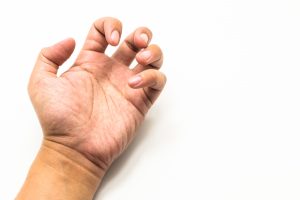The Consequences of Spasticity and Indications for Treatment include:

- Pain related to altered posture.
- Mobility limitation.
- Skin vulnerability – spasticity leads to increased shearing forces affecting specific muscle groups (e.g. increased tone in knee flexors in a supine patient creates friction at heels and buttocks).
- Difficulties in maintaining hygiene – typically this occurs in:
- The groin or perineal areas, where adducted hips limit ability to clean skin.
- The palms where flexed fingers prevent cleaning but may also lead to excessive perspiration.
- The elbow flexures and axillae.
- Loss of joint range – In addition to impact of spasticity in limiting active movement, if a contracture develops it will have permanent effects in limiting the range of joint movement, which is especially important in terms of plantar flexor, knee flexor or hip flexor tone because contractures in these areas will subsequently limit the person’s ability to walk.
- Cosmesis – visible deformity in limb posture will impact on body image.
- Altered posture – spasticity or contracture can limit the person’s ability to sit or maintain comfortable positioning.
- Loss of function – activities which are particularly affected include walking, dressing, personal care, meal preparation etc.
Consequences of Immobility which are associated with Spasticity include:
- Venous Thromboembolism (VTE).
- Respiratory infection due to poor ventilation and sputum clearance.
- Constipation (may aggravate spasticity).
- Incontinence (may cause skin irritation which aggravates spasticity).
- Pressure ulcers.
- Worsening immobility due to reduced movement and muscle disuse.
- Worsening confusion.
- Risk of isolation/neglect.
Note: Sometimes spasticity can be helpful for the patient with a paresis in that it may provide weight bearing potential in an otherwise weakened limb.